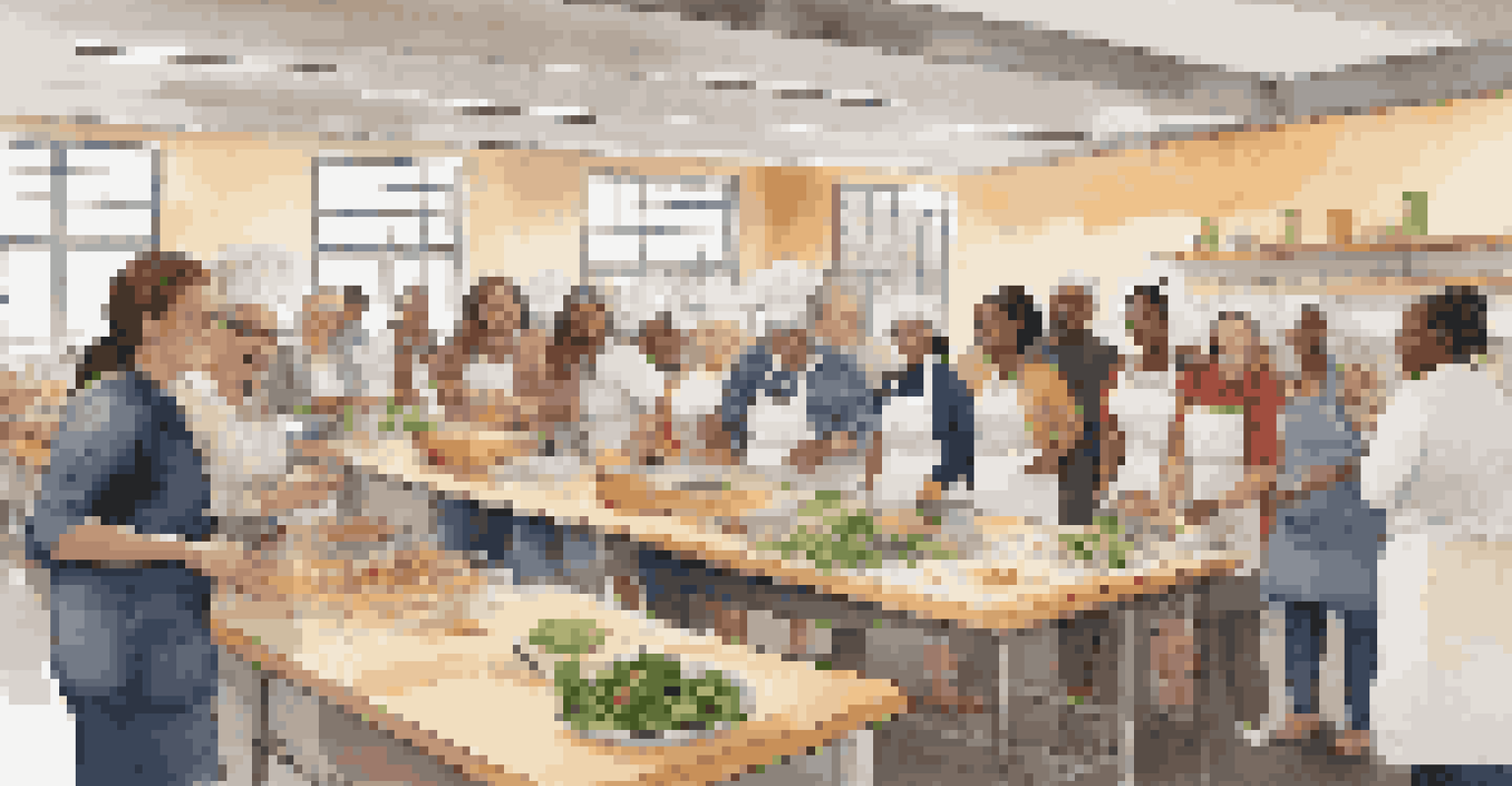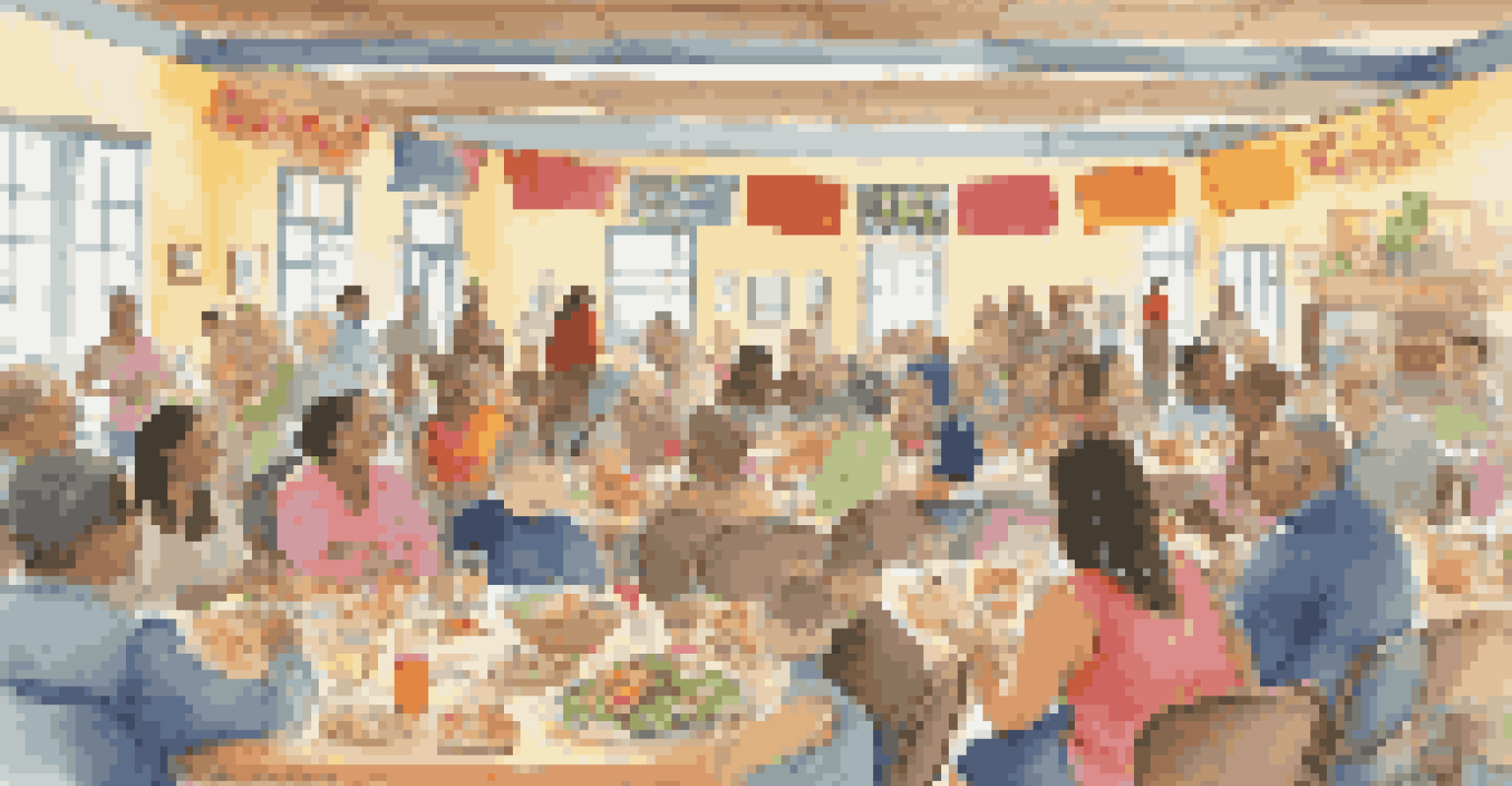The Importance of Community in Supporting Nutrition Education

Community as a Pillar of Nutrition Education
Communities play a vital role in shaping dietary habits and nutritional knowledge. When people come together, they can share valuable information and resources that promote healthier eating. This collective effort not only fosters a sense of belonging but also enhances the overall impact of nutrition education.
Nutrition education is not just about teaching; it's about creating a community that supports healthy choices.
By leveraging local knowledge and experiences, communities can create tailored educational programs that resonate with their members. For instance, a neighborhood might host workshops that focus on culturally relevant foods and cooking methods, making the information more relatable and practical. Such initiatives often lead to lasting changes in dietary behaviors.
Moreover, community involvement ensures that nutrition education is not just a one-time event but an ongoing conversation. Regular gatherings, like potlucks or farmer's markets, provide opportunities for individuals to continue learning and sharing tips about healthy eating, reinforcing positive habits over time.
Building Connections Through Shared Experiences
When individuals engage in nutrition education together, they build connections that make learning more enjoyable. Shared experiences, such as cooking classes or group meal prep sessions, create a supportive environment where participants feel comfortable asking questions and sharing their struggles. This camaraderie can significantly enhance the learning process.

For example, a community garden can serve as both an educational tool and a social hub. Participants learn about growing fresh produce while also connecting with others who share similar health goals. These relationships can foster accountability, encouraging everyone to stick to their nutrition commitments.
Additionally, these shared experiences can lead to the formation of support networks. Whether it’s a group of parents learning about healthy snacks for their kids or seniors discussing balanced meals, these networks provide a platform for ongoing motivation and encouragement, making healthy eating a communal effort.
Addressing Food Insecurity Through Community Action
Food insecurity is a pressing issue that many communities face, directly impacting nutrition education efforts. By coming together, communities can address this challenge head-on, ensuring that everyone has access to healthy food options. Initiatives such as food drives, community kitchens, or local farmers' markets can help bridge the gap.
Alone we can do so little; together we can do so much.
For instance, a local organization might partner with schools to provide fresh produce to families in need. This not only supports nutrition education but also empowers families to make healthier choices by providing them with the resources they require. When communities prioritize access to nutritious food, everyone benefits.
Moreover, these collective efforts can raise awareness about the importance of nutrition in combatting food insecurity. Educational campaigns that highlight the connection between a balanced diet and overall well-being can motivate community members to advocate for better food policies and resources in their area.
Utilizing Local Resources for Effective Education
Communities often have a wealth of local resources that can enhance nutrition education. From health professionals to local chefs, tapping into these resources can provide invaluable insights and expertise. Collaborating with local stakeholders ensures that the information shared is relevant and trustworthy.
For example, a local dietitian might conduct workshops at community centers, offering practical tips on meal planning and grocery shopping. This hands-on approach makes nutrition education more accessible and actionable, allowing participants to apply what they learn immediately. When education is grounded in local context, its impact is often amplified.
Additionally, local businesses can play a pivotal role by sponsoring events or providing healthy food options. This kind of partnership not only supports nutrition education initiatives but also promotes local economic growth. When communities come together to support one another, everyone wins.
Engaging Youth in Nutrition Education Initiatives
Involving youth in nutrition education is crucial for fostering lifelong healthy habits. When young people participate in community initiatives, they become ambassadors for nutrition within their families and peer groups. This ripple effect can lead to broader changes in dietary behaviors across generations.
Programs like school gardens or cooking clubs can engage students in hands-on learning about nutrition. These activities not only teach essential cooking skills but also encourage children to appreciate fresh fruits and vegetables. By making nutrition fun and interactive, communities can instill a love for healthy eating early on.
Moreover, youth involvement can bring fresh perspectives to nutrition education. When young people contribute their ideas and preferences, educational programs can evolve to meet their needs, ensuring that the content remains relevant and engaging. This collaboration fosters a sense of ownership and pride in their community's health.
Promoting Cultural Diversity in Nutrition Education
Cultural diversity enriches nutrition education by introducing various culinary traditions and practices. Communities that celebrate their diverse backgrounds can create inclusive educational programs that resonate with everyone. This approach not only promotes acceptance but also broadens participants' understanding of nutrition.
For example, a community might host an international potluck where members share recipes from their cultures. This fosters a sense of pride and belonging while allowing participants to learn about different foods and their nutritional benefits. Embracing cultural diversity in nutrition education can make learning more engaging and relatable.
Additionally, recognizing and respecting cultural food practices can enhance the effectiveness of nutrition education. When programs acknowledge individual preferences and traditions, participants are more likely to embrace healthy eating. This cultural sensitivity can lead to a more inclusive and impactful educational experience.
Sustaining Community Efforts for Long-term Impact
Sustaining community efforts in nutrition education requires ongoing commitment and collaboration. Establishing a solid foundation through regular meetings and feedback allows programs to adapt and thrive over time. When community members feel invested, they are more likely to contribute to the longevity of these initiatives.
For instance, forming a nutrition education committee can help maintain momentum and ensure that programs continue to evolve. This group can assess the community’s needs, gather resources, and organize events that keep nutrition education at the forefront. Sustained efforts lead to lasting changes in dietary behaviors and community health.

Moreover, celebrating successes and milestones can motivate continued participation. Recognizing individuals and groups for their contributions fosters a sense of pride and encourages others to get involved. By celebrating achievements, communities can create a positive feedback loop that supports ongoing nutrition education efforts.